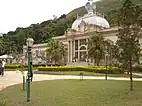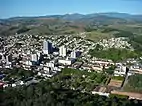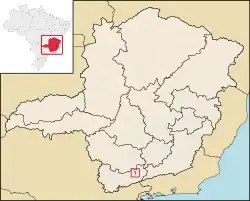Caxambu | |
|---|---|
| Municipality of Caxambu | |
     .jpg.webp)  | |
 Flag  Coat of arms | |
| Nickname: Cidade das Águas | |
| Motto(s): Medicina entre flores "Medicine among flowers" | |
 Location in Minas Gerais | |
| Coordinates: 21°58′37″S 44°55′58″W / 21.97694°S 44.93278°W / -21.97694; -44.93278 | |
| Country | |
| State | |
| Region | Southeast |
| Intermediate Region | Pouso Alegre |
| Immediate Region | Caxambu-Baependi |
| Founded | 16 September 1901 |
| Government | |
| • Mayor | Diogo Curi Hauegen (PSDB) |
| Area | |
| • Total | 100.203 km2 (38.689 sq mi) |
| Elevation | 895 m (2,936 ft) |
| Population (2021)[2] | |
| • Total | 21,566 |
| • Density | 220/km2 (560/sq mi) |
| Demonym | caxambuense |
| Time zone | UTC−3 (BRT) |
| HDI (2010) | 0.743 – high[3] |
| Website | caxambu |
Caxambu is a Brazilian municipality in Minas Gerais. Its population in 2021 was estimated at 21,566.
Caxambu is renowned for its spa which has twelve sources of mineral sparkling water flowing 24 hours a day and a cold-water geyser.[4]
 Mineral waters
Mineral waters
References
- ↑ "Área territorial oficial". Resolução da Presidência do IBGE de n° 5 (R.PR-5/02). 10 October 2002. Retrieved 5 December 2010.
- ↑ "IBGE Caxambu". IBGE. Retrieved 14 March 2022.
- ↑ "Archived copy" (PDF). United Nations Development Programme (UNDP). Archived from the original (PDF) on July 8, 2014. Retrieved August 1, 2013.
{{cite web}}: CS1 maint: archived copy as title (link) - ↑ Bonotto, Daniel Marcos (2016). "Hydrogeochemical study of spas groundwaters from southeast Brazil". Journal of Geochemical Exploration. Elsevier BV. 169: 60–72. doi:10.1016/j.gexplo.2016.07.016. hdl:11449/173240.
External links
 Caxambu travel guide from Wikivoyage
Caxambu travel guide from Wikivoyage
21°59′S 44°55′W / 21.983°S 44.917°W / -21.983; -44.917
Authority control databases | |
|---|---|
| International | |
| National | |
This article is issued from Wikipedia. The text is licensed under Creative Commons - Attribution - Sharealike. Additional terms may apply for the media files.
